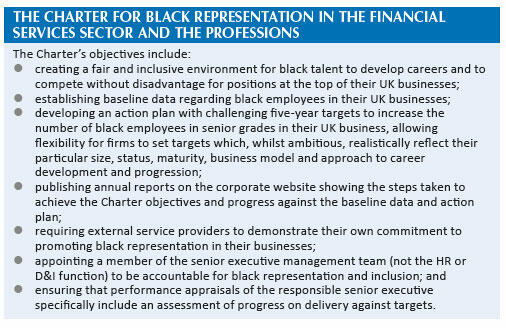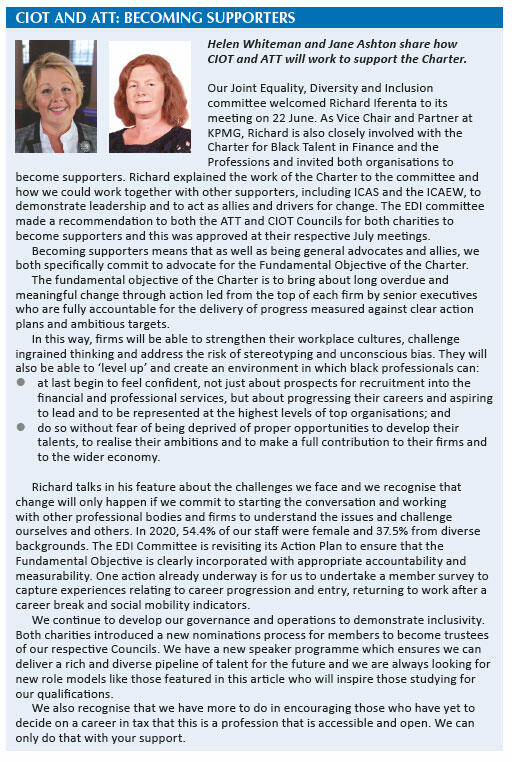Boosting black representation

As CIOT and ATT become supporters of the Charter for Black Talent in the Financial Services Sector and the Professions, Richard Iferenta explains what the Charter seeks to achieve
Over the last few years, the outcry for more diversity and inclusion has grown noticeably louder – and rightly so. With the tragic murder of George Floyd, we saw a sharpening of the focus on the challenges black people face, not just in America but also here in the United Kingdom. One of the effects we have seen as a result is that the concern has spilled over into the business world with numerous businesses identifying that there is a paucity of black people in senior management and leadership positions. A substantial and increasing body of evidence and data shows that black people are the most under-represented ethnic group in business, who face the greatest hurdles, negative stereotypes and challenges in recruitment and promotion to senior positions.
Many businesses have made commitments to address this issue by breaking the glass ceiling and improving their recruitment processes by removing barriers to entry and progression.
The winds of change led to the birth of the Charter for Black Talent in the Financial Services Sector and the Professions. The Charter models itself on the Women in Finance Charter, which is backed by HM Treasury and signatory firms to work together to build a more balanced and fair financial services industry.
The objectives of the Charter are laudable: in summary, creating more opportunities for the recruitment and career progression of black people in the relevant sectors; and, importantly, measuring progress with data to ensure transparency and accountability.
The tax profession has historically not been the most welcoming to ethnic minorities. Indeed, I recall all those decades ago when I started my career in tax and it was a rarity to meet black colleagues. The few black people were mainly in junior roles with little hope of progressing beyond manager. Decades later, we now see more than a sprinkling of black people in the tax profession, but there are still very few black tax partners, directors or senior managers.
A few months ago, Helen Whiteman (CIOT CEO) and I spoke at a very engaging and interactive Women in Tax event, which triggered a series of discussions around diversity and inclusion across the board, including how the CIOT and ATT are well placed to drive change in a profession that seems absolutely ready for it! Some of the challenges that Helen and the broader EDI Committee committed to address include:
a) How do we attract black talent to the profession?
b) How do we make those who join feel welcome in the profession?
c) How do we ensure they are given equal opportunities to get the same quality of work as their peer group and the same sort of client exposure as others?
d) How do we ensure that black colleagues who join the profession are not held back because they do not have the right support or indeed sponsorship?
It is recognised that the CIOT can only set the framework and then encourage the professional firms who provide taxation services to live up to the commitments made to the Charter. I am very excited about the CIOT and ATT supporting the Charter and I’m keen to see what differences this will make in
practice. Clearly, over the next couple of years I am hoping to see greater diversity not just in the CIOT and ATT staff and leadership, but in the profession at large. A quick win in trying to drive change would be for the CIOT and ATT to start to embed diversity and inclusion values into their ethics training and standards. These standards should include the commitments made to the Charter but also broader commitments in relation to gender identity, sexual orientation, disability, socio-economic background and religion.
The FCA recently made a bold statement requiring listed companies to have diverse boards or explain why they do not. We have seen the Discussion Paper 21/2 issued in July from the Bank of England, FCA and the PRA (see bit.ly/39l4YBB), setting the agenda and being clear on the need for financial institutions to take diversity seriously. They have made it clear that this will be a priority for them in the coming years.
Now is absolutely the right time for the CIOT and ATT to drive change. Often, people ask ‘What does good look like?’ To me, good would be seeing the profession stand up and make commitments to specifically target recruits from the black community. But it’s not just about recruitment; it’s also about making sure appropriate processes are in place for those recruits to ensure that they feel welcome in what can be a pretty daunting environment for the uninitiated!




